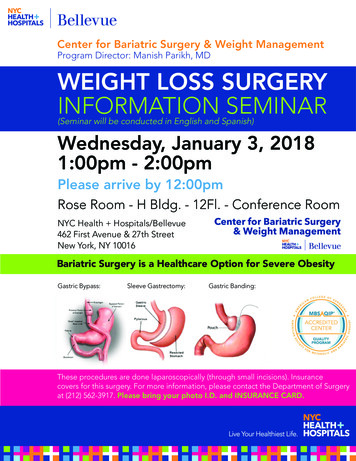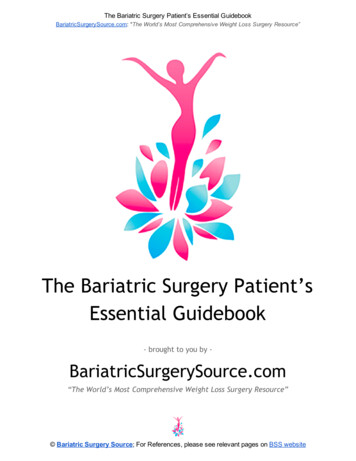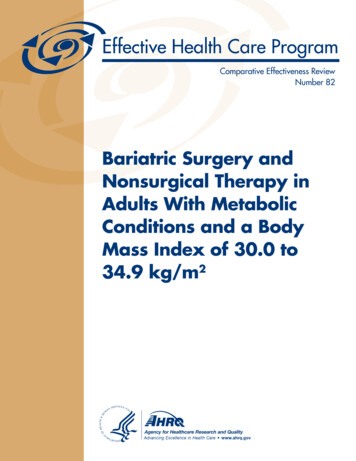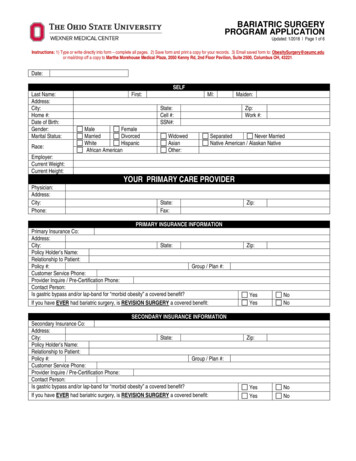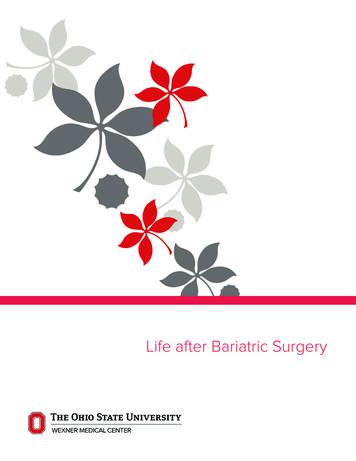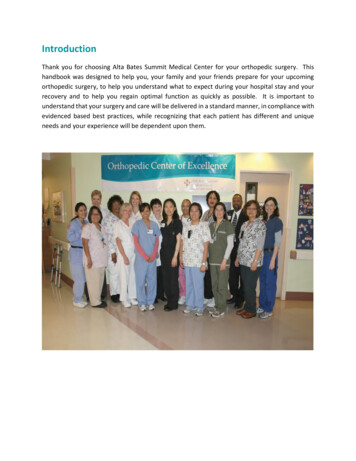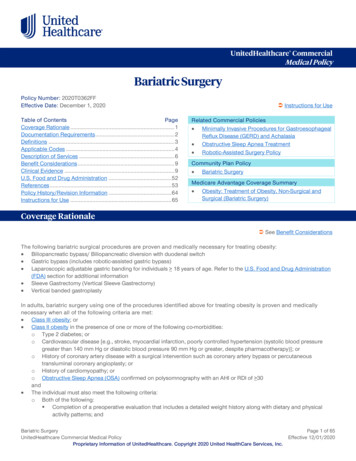
Transcription
UnitedHealthcare CommercialMedical PolicyBariatric SurgeryPolicy Number: 2020T0362FFEffective Date: December 1, 2020Table of ContentsPageCoverage Rationale . 1Documentation Requirements . 2Definitions . 3Applicable Codes . 4Description of Services . 6Benefit Considerations . 9Clinical Evidence . 9U.S. Food and Drug Administration . 52References . 53Policy History/Revision Information . 64Instructions for Use . 65 Instructions for UseRelated Commercial Policies Minimally Invasive Procedures for GastroesophagealReflux Disease (GERD) and Achalasia Obstructive Sleep Apnea Treatment Robotic-Assisted Surgery PolicyCommunity Plan Policy Bariatric SurgeryMedicare Advantage Coverage Summary Obesity: Treatment of Obesity, Non-Surgical andSurgical (Bariatric Surgery)Coverage Rationale See Benefit ConsiderationsThe following bariatric surgical procedures are proven and medically necessary for treating obesity:Biliopancreatic bypass/ Biliopancreatic diversion with duodenal switchGastric bypass (includes robotic-assisted gastric bypass)Laparoscopic adjustable gastric banding for individuals 18 years of age. Refer to the U.S. Food and Drug Administration(FDA) section for additional informationSleeve Gastrectomy (Vertical Sleeve Gastrectomy)Vertical banded gastroplastyIn adults, bariatric surgery using one of the procedures identified above for treating obesity is proven and medicallynecessary when all of the following criteria are met:Class III obesity; orClass II obesity in the presence of one or more of the following co-morbidities:o Type 2 diabetes; oro Cardiovascular disease [e.g., stroke, myocardial infarction, poorly controlled hypertension (systolic blood pressuregreater than 140 mm Hg or diastolic blood pressure 90 mm Hg or greater, despite pharmacotherapy)]; oro History of coronary artery disease with a surgical intervention such as coronary artery bypass or percutaneoustransluminal coronary angioplasty; oro History of cardiomyopathy; oro Obstructive Sleep Apnea (OSA) confirmed on polysomnography with an AHI or RDI of 30andThe individual must also meet the following criteria:o Both of the following: Completion of a preoperative evaluation that includes a detailed weight history along with dietary and physicalactivity patterns; andBariatric SurgeryPage 1 of 65UnitedHealthcare Commercial Medical PolicyEffective 12/01/2020Proprietary Information of UnitedHealthcare. Copyright 2020 United HealthCare Services, Inc.
oPsychosocial-behavioral evaluation by an individual who is professionally recognized as part of a behavioral healthdiscipline to provide screening and identification of risk factors or potential postoperative challenges that maycontribute to a poor postoperative outcomeorParticipation in a multi-disciplinary surgical preparatory regimenIn Adolescents, the bariatric surgical procedures identified above are proven and medically necessary for treating obesitywhen all of the following criteria are met:Class III obesity; orClass II obesity in the presence of one or more of the following co-morbidities:o Type 2 diabetes; oro Cardiovascular disease [e.g., stroke, myocardial infarction, poorly controlled hypertension (systolic blood pressuregreater than 140 mm Hg or diastolic blood pressure 90 mm Hg or greater, despite pharmacotherapy)]; oro History of coronary artery disease with a surgical intervention such as coronary artery bypass or percutaneoustransluminal coronary angioplasty; oro History of cardiomyopathy; oro Obstructive Sleep Apnea confirmed on polysomnography with an AHI or RDI of 30andThe individual must also receive an evaluation at, or in consultation with, a multidisciplinary center focused on the surgicaltreatment of severe childhood obesity. This may include adolescent centers that have received accreditation by theMetabolic and Bariatric Surgery Accreditation and Quality Improvement Program (MBSAQIP) or can demonstrate similarprogrammatic components.Revisional Bariatric Surgery using one of the procedures identified above is proven and medically necessary when due toa Technical Failure or Major Complication from the initial bariatric procedure.The following procedures are unproven and not medically necessary for treating obesity due to insufficient evidence ofefficacy:Revisional Bariatric Surgery for any other indication than those listed aboveBariatric surgery as the primary treatment for any condition other than obesityBariatric surgical interventions for the treatment of obesity including but not limited to:o Bariatric artery embolization (BAE)o Gastric electrical stimulation with an implantable gastric stimulator (IGS)o Intragastric balloono Laparoscopic greater curvature plication, also known as total gastric vertical plicationo Mini-gastric bypass (MGB)/Laparoscopic mini-gastric bypass (LMGBP)o Single-Anastomosis Duodenal Switch (also known as duodenal switch with single anastomosis, or stomach intestinalpylorus sparing surgery [SIPS])o Stomach aspiration therapy (AspireAssist )o Transoral endoscopic surgery (includes TransPyloric Shuttle (TPS ) Device)o Vagus Nerve Blocking (VBLOC )Gastrointestinal liners (EndoBarrier ) are investigational, unproven and not medically necessary for treating obesity due tolack of U.S. Food and Drug Administration (FDA) approval, and insufficient evidence of efficacy.Documentation RequirementsBenefit coverage for health services is determined by the member specific benefit plan document and applicable laws that mayrequire coverage for a specific service. The documentation requirements outlined below are used to assess whether themember meets the clinical criteria for coverage but do not guarantee coverage of the service requested.Bariatric SurgeryPage 2 of 65UnitedHealthcare Commercial Medical PolicyEffective 12/01/2020Proprietary Information of UnitedHealthcare. Copyright 2020 United HealthCare Services, Inc.
CPT Codes*Bariatric Surgery0312T, 0313T,0314T, 0315T,0316T, 0317T,43644, 43645,43647, 43648,43659, 43770,43771, 43772,43773, 43774,43775, 43842,43843, 43845,43846, 43847,43848, 43881,43882, 43886,43887, 43888,64590, 64595,Required Clinical InformationMedical notes documenting all of the following:HeightWeightCurrent and five year history of BMI (body mass index)Diet historyCo-morbiditiesMedical treatment tried and failed including diet and exercisePsychological evaluation by a licensed behavioral health professionalNutritional consultName of the facility where the procedure will be performedSubsequent Bariatric Surgery4386043865Medical notes documenting all of the following:HeightWeightBMI (body mass index)Diet historyCo-morbiditiesPrevious unsuccessful medical treatmentName of the facility where the procedure will be performedInitial bariatric surgery performed and date and subsequent complications that require furthersurgical intervention*For code descriptions, see the Applicable Codes section.DefinitionsAdolescent: Individuals 12-21 years of age (Hardin and Hackell [American Academy of Pediatrics], 2017).For the purposes of this policy, adults are considered 18 years of age.Body Mass Index (BMI): A person's weight in kilograms divided by the square of height in meters. BMI can be used as ascreening tool but is not diagnostic of the body fatness or health of an individual (Centers for Disease Control and Prevention[CDC], 2017).The National Heart, Lung and Blood Institute (NHLBI) (Jensen et al., 2013) classifies the ranges of BMI in adults as follows: 18.5 - Underweight18.5 to 24.9 kg/m2 – Normal Weight25-29.9 kg/m2 – Overweight30-34.9 kg/m2 – Obesity Class I35-39.9 kg/m2 – Obesity Class II 40 kg/m2 – Extreme Obesity Class IIIThe American Society of Metabolic and Bariatric Surgeons (ASMBS; Pratt et al., 2018), classifies severe obesity in adolescentsas follows:Class II obesity – 120% of the 95th percentile height, or an absolute BMI of 35-39.9 kg/m2, whichever is lower*Class III obesity – 140% of the 95th percentile height, or an absolute BMI of 40 kg/m2, whichever is lower*Also as defined by the American Heart Association (Kelly et al., 2013).Bariatric SurgeryPage 3 of 65UnitedHealthcare Commercial Medical PolicyEffective 12/01/2020Proprietary Information of UnitedHealthcare. Copyright 2020 United HealthCare Services, Inc.
Multidisciplinary: Combining or involving several academic disciplines or professional specializations in an approach to createa well-trained, safe and effective environment for the complex bariatric patient. Building the multidisciplinary team includes staffsuch as the bariatric surgeon, obesity medicine specialist, registered dietician, specialized nursing, behavioral health specialist,exercise specialist and support groups (American Society for Metabolic and Bariatric Surgery (ASMBS) textbook of bariatricsurgery).Obstructive Sleep Apnea (OSA): The American Academy of Sleep Medicine (AASM) defines OSA as a sleep related breathingdisorder that involves a decrease or complete halt in airflow despite an ongoing effort to breathe. OSA severity is defined as:Mild for AHI or RDI 5 and 15Moderate for AHI or RDI 15 and 30Severe for AHI or RDI 30/hrFor additional information, refer to the Medical Policy titled Obstructive Sleep Apnea Treatment.Revisional Bariatric Surgery:Conversion – A second bariatric procedure that changes the bariatric approach from the index procedure to a differenttype of procedure (e.g., sleeve gastrectomy or adjustable gastric band converted to Roux-en-Y [RYGB]). Note: This is not tothe same as an intraoperative conversion (e.g., converting from laparoscopic approach to an open procedure).Revision or Corrective – A procedure that corrects or modifies anatomy of a previous bariatric procedure to improve theintended outcome or correct a complication. These procedures also address device manipulation (e.g., gastric pouchresizing, re-sleeve gastrectomy, limb length adjustments in RYGB and gastric band replacement).Reversal – A procedure that restores original anatomy.(Hayes, 2018)Technical Failure or Major Complication: Potential issues related to bariatric procedures include but are not limited to thefollowing:Bowel perforation (including adjustable gastric band erosion)Adjustable gastric band migration (slippage) that cannot be corrected with manipulation or adjustment. (Records mustdemonstrate that manipulation or adjustment to correct band slippage has been attempted.)LeakObstruction (confirmed by imaging studies)Staple-line failureMechanical adjustable gastric band failureApplicable CodesThe following list(s) of procedure and/or diagnosis codes is provided for reference purposes only and may not be all inclusive.Listing of a code in this policy does not imply that the service described by the code is a covered or non-covered health service.Benefit coverage for health services is determined by the member specific benefit plan document and applicable laws that mayrequire coverage for a specific service. The inclusion of a code does not imply any right to reimbursement or guarantee claimpayment. Other Policies and Guidelines may apply.Coding Clarification: Utilize CPT code 43775 to report laparoscopic sleeve gastrectomy rather than the unlisted CPT code43659.CPT Code0312TDescriptionVagus nerve blocking therapy (morbid obesity); laparoscopic implantation of neurostimulator electrodearray, anterior and posterior vagal trunks adjacent to esophagogastric junction (EGJ), with implantationof pulse generator, includes programming0313TVagus nerve blocking therapy (morbid obesity); laparoscopic revision or replacement of vagal trunkneurostimulator electrode array, including connection to existing pulse generator0314TVagus nerve blocking therapy (morbid obesity); laparoscopic removal of vagal trunk neurostimulatorelectrode array and pulse generatorBariatric SurgeryPage 4 of 65UnitedHealthcare Commercial Medical PolicyEffective 12/01/2020Proprietary Information of UnitedHealthcare. Copyright 2020 United HealthCare Services, Inc.
CPT Code0315TDescriptionVagus nerve blocking therapy (morbid obesity); removal of pulse generator0316TVagus nerve blocking therapy (morbid obesity); replacement of pulse generator0317TVagus nerve blocking therapy (morbid obesity); neurostimulator pulse generator electronic analysis,includes reprogramming when performed43644Laparoscopy, surgical, gastric restrictive procedure; with gastric bypass and Roux-en-Ygastroenterostomy (roux limb 150 cm or less)43645Laparoscopy, surgical, gastric restrictive procedure; with gastric bypass and small intestinereconstruction to limit absorption43647Laparoscopy, surgical; implantation or replacement of gastric neurostimulator electrodes, antrum43648Laparoscopy, surgical; revision or removal of gastric neurostimulator electrodes, antrum43659Unlisted laparoscopy procedure, stomach43770Laparoscopy, surgical, gastric restrictive procedure; placement of adjustable gastric restrictive device(e.g., gastric band and subcutaneous port components)43771Laparoscopy, surgical, gastric restrictive procedure; revision of adjustable gastric restrictive devicecomponent only43772Laparoscopy, surgical, gastric restrictive procedure; removal of adjustable gastric restrictive devicecomponent only43773Laparoscopy, surgical, gastric restrictive procedure; removal and replacement of adjustable gastricrestrictive device component only43774Laparoscopy, surgical, gastric restrictive procedure; removal of adjustable gastric restrictive device andsubcutaneous port components43775Laparoscopy, surgical, gastric restrictive procedure; longitudinal gastrectomy (i.e., sleeve gastrectomy)43842Gastric restrictive procedure, without gastric bypass, for morbid obesity; vertical-banded gastroplasty43843Gastric restrictive procedure, without gastric bypass, for morbid obesity; other than vertical-bandedgastroplasty43845Gastric restrictive procedure with partial gastrectomy, pylorus-preserving duodenoileostomy andileoileostomy (50 to 100 cm common channel) to limit absorption (biliopancreatic diversion withduodenal switch)43846Gastric restrictive procedure, with gastric bypass for morbid obesity; with short limb (150 cm or less)Roux-en-Y gastroenterostomy43847Gastric restrictive procedure, with gastric bypass for morbid obesity; with small intestine reconstructionto limit absorption43848Revision, open, of gastric restrictive procedure for morbid obesity, other than adjustable gastricrestrictive device (separate procedure)43860Revision of gastrojejunal anastomosis (gastrojejunostomy) with reconstruction, with or without partialgastrectomy or intestine resection; without vagotomy43865Revision of gastrojejunal anastomosis (gastrojejunostomy) with reconstruction, with or without partialgastrectomy or intestine resection; with vagotomy43881Implantation or replacement of gastric neurostimulator electrodes, antrum, open43882Revision or removal of gastric neurostimulator electrodes, antrum, open43886Gastric restrictive procedure, open; revision of subcutaneous port component only43887Gastric restrictive procedure, open; removal of subcutaneous port component only43888Gastric restrictive procedure, open; removal and replacement of subcutaneous port component only43999Unlisted procedure, stomach64590Insertion or replacement of peripheral or gastric neurostimulator pulse generator or receiver, direct orinductive couplingBariatric SurgeryPage 5 of 65UnitedHealthcare Commercial Medical PolicyEffective 12/01/2020Proprietary Information of UnitedHealthcare. Copyright 2020 United HealthCare Services, Inc.
CPT Code64595DescriptionRevision or removal of peripheral or gastric neurostimulator pulse generator or receiverCPT is a registered trademark of the American Medical AssociationDescription of ServicesObesityObesity and weight are defined clinically using the Body Mass Index (BMI). Obesity is a significant health concern due to itshigh prevalence and associated health risks.Health consequences associated with obesity include hypertension, Type II diabetes, hyperlipidemia, atherosclerosis, heartdisease, stroke, diseases of the gallbladder, osteoarthritis, certain types of cancer, Obstructive Sleep Apnea and respiratoryproblems. In addition, certain cancers are more prevalent in obese individuals, including endometrial, ovarian, breast, prostate,colon cancer, renal cell carcinoma, and non-Hodgkin's lymphoma.The U.S. Preventive Services Task Force (USPSTF) recommends screening all adults for obesity. Clinicians should offer or referpatients with a BMI of 30 kg/m2 or higher to intensive, multicomponent behavioral interventions (USPSTF, 2012).The National Center for Health Statistics (Centers for Disease Control and Prevention [CDC], 2017) reports that in 2015-2016,the prevalence of obesity was 39.8% in adults and 18.5% in children. The observed change in prevalence between 2013–2014and 2015–2016 was not significant among adults and youth.The National Heart, Lung, and Blood Institute (NHLBI) Obesity Expert Panel (2013) estimates that 8.1% of women, and 4.4% ofmen in the U.S. population has a BMI over 40. The NHLBI clarified that the term Class III or Extreme Obesity has replaced theterm “morbid obesity.” The American Society for Metabolic and Bariatric Surgery (American Society of Metabolic and BariatricSurgery [ASMBS]) (English et al., 2016) estimates there were over 216,000 bariatric surgery procedures in 2016.Bariatric Surgery in the Adolescent PopulationFor adolescents, physical development and maturation may be determined utilizing the gender specific growth chart and BMIchart developed by the CDC, National Center for Health Statistics (2017).First-Line Treatments for ObesityFirst-line treatments for obesity include dietary therapy, physical activity, behavior modification, and medication management;all of which have generally been unsuccessful in long-term weight management for obese individuals (Lannoo and Dillemans,2014).Bariatric Surgical ProceduresThe goal of surgical treatment for obesity is to induce significant weight loss and, thereby, reduce the incidence or progressionof obesity-related comorbidities, as well as to improve quality of life. The purpose of performing bariatric surgery in adolescentpatients is to reduce the lifelong impact of severe obesity.Surgical treatment of obesity offers two main weight-loss approaches: restrictive and malabsorptive. Restrictive methods areintended to cause weight loss by restricting the amount of food that can be consumed by reducing the size of the stomach.Malabsorptive methods are intended to cause weight loss by limiting the amount of food that is absorbed from the intestinesinto the body. A procedure can have restrictive features, malabsorptive features, or both. The surgical approach can be open orlaparoscopic. The clinical decision on which surgical procedure to use is made based on a medical assessment of the patient'sunique situation.Roux-en-y Bypass (RYGB)/Gastric BypassThe RYGB procedure involves creating a stomach pouch out of a small portion of the stomach and attaching it directly to thesmall intestine, bypassing a large part of the stomach and duodenum.Bariatric SurgeryPage 6 of 65UnitedHealthcare Commercial Medical PolicyEffective 12/01/2020Proprietary Information of UnitedHealthcare. Copyright 2020 United H
Revisional Bariatric Surgery: Conversion – A second bariatric procedure that changes the bariatric approach from the index procedure to a different type of procedure (e.g., sleeve gastrectomy or
